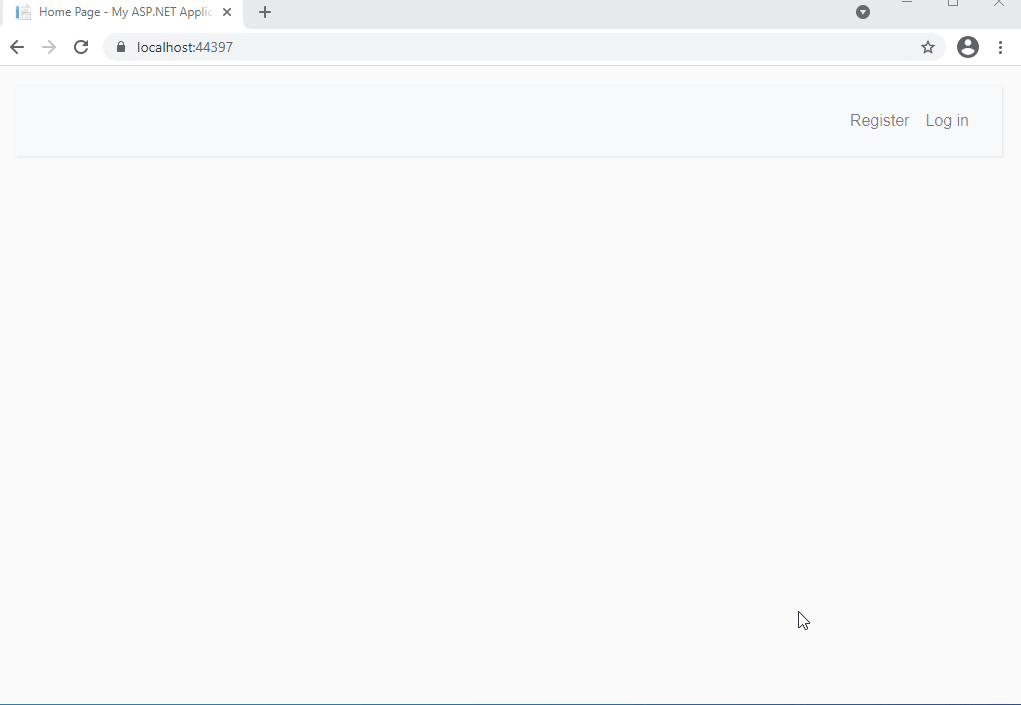C# 基于角色的动态左侧菜单(使用ASP .NET Identity)
实现一个基于用户角色的左侧栏菜单
- 创建一个ASP .NET Identity的模板项目。
- 修改模板项目的_Layout视图,实现左侧菜单。
- 创建一个Menu的class用存储菜单信息,并且创建ApplicationUserRole(让它继承IdentityRole),并且配置Menu和ApplicationUserRole之间多对多的关系。
- 可以点击链接去下载完整的项目,也可以直接查看下面的代码(只粘贴了部分)。
- 有时间我会慢慢加上注释的。
Menus
using Microsoft.AspNet.Identity.EntityFramework;
using Newtonsoft.Json;
using System;
using System.Collections.Generic;
using System.ComponentModel.DataAnnotations;
using System.ComponentModel.DataAnnotations.Schema;
using System.Linq;
using System.Web;
using System.Xml.Serialization;
namespace DynamicLeftMenuBasedRoleMVCIdentityDemo.Models
{
[JsonObject(IsReference = true)]
public class Menus
{
[Key]
public int MainMenuId { get; set; }
public string MainMenuName { get; set; }
public string MainMenuUrl { get; set; }
public int? ParentMenuId { get; set; }
[ForeignKey("ParentMenuId")]
public List SubMenus { get; set; }
public List ApplicationUserRoles { get; set; }
}
} IdentityModels
using System.Collections.Generic;
using System.Data.Entity;
using System.Linq;
using System.Security.Claims;
using System.Threading.Tasks;
using Microsoft.AspNet.Identity;
using Microsoft.AspNet.Identity.EntityFramework;
using Newtonsoft.Json;
namespace DynamicLeftMenuBasedRoleMVCIdentityDemo.Models
{
// You can add profile data for the user by adding more properties to your ApplicationUser class, please visit https://go.microsoft.com/fwlink/?LinkID=317594 to learn more.
public class ApplicationUser : IdentityUser
{
public async Task GenerateUserIdentityAsync(UserManager manager)
{
// Note the authenticationType must match the one defined in CookieAuthenticationOptions.AuthenticationType
var userIdentity = await manager.CreateIdentityAsync(this, DefaultAuthenticationTypes.ApplicationCookie);
ApplicationDbContext context = new ApplicationDbContext();
var roleManager = new RoleManager(new RoleStore(context));
var role = manager.GetRoles(userIdentity.GetUserId())[0].ToString();
var roleid = roleManager.Roles.Where(m => m.Name == role).Select(m => m.Id).FirstOrDefault();
var menulist = context.Menus.Include("ApplicationUserRoles").Include("SubMenus").Where(m => m.ApplicationUserRoles.Any(i => i.Id == roleid)).ToList();
var menulistjsonstring = JsonConvert.SerializeObject(menulist, Formatting.Indented,
new JsonSerializerSettings
{
PreserveReferencesHandling = PreserveReferencesHandling.Objects
});
userIdentity.AddClaim(new Claim("menulist", menulistjsonstring));
// Add custom user claims here
return userIdentity;
}
}
public class ApplicationUserRole: IdentityRole
{
public List Menus { get; set; }
}
public class ApplicationDbContext : IdentityDbContext
{
public ApplicationDbContext()
: base("DefaultConnection", throwIfV1Schema: false)
{
}
public DbSet Menus { get; set; }
public static ApplicationDbContext Create()
{
return new ApplicationDbContext();
}
protected override void OnModelCreating(DbModelBuilder modelBuilder)
{
base.OnModelCreating(modelBuilder);
modelBuilder.Entity()
.HasMany(m=>m.Menus)
.WithMany(m=>m.ApplicationUserRoles).Map(cs =>
{
cs.MapLeftKey("RoleId");
cs.MapRightKey("MainMenuId");
cs.ToTable("AspNetRolesMenus");
});
}
}
} _LeftMenu.cshtml
@using Microsoft.AspNet.Identity
@using DynamicLeftMenuBasedRoleMVCIdentityDemo.Models
_Layout.cshtml
@ViewBag.Title - My ASP.NET Application
@Styles.Render("~/Content/css")
@Scripts.Render("~/bundles/modernizr")
@using Microsoft.AspNet.Identity
@if (Request.IsAuthenticated)
{
@Html.Partial("_LeftMenu")
}
@RenderBody()
@Scripts.Render("~/bundles/jquery")
@Scripts.Render("~/bundles/bootstrap")
@RenderSection("scripts", required: false)
Startup.cs
using DynamicLeftMenuBasedRoleMVCIdentityDemo.Models;
using Microsoft.AspNet.Identity;
using Microsoft.AspNet.Identity.EntityFramework;
using Microsoft.Owin;
using Owin;
using System;
using System.Collections.Generic;
using System.Linq;
[assembly: OwinStartupAttribute(typeof(DynamicLeftMenuBasedRoleMVCIdentityDemo.Startup))]
namespace DynamicLeftMenuBasedRoleMVCIdentityDemo
{
public partial class Startup
{
public void Configuration(IAppBuilder app)
{
ConfigureAuth(app);
createRolesandUsers();
createRolesandMenus();
}
private List getApplicationUserRoles(int i, List allroles)
{
List list = new List();
if (i == 3)
{
list = allroles.ToList();
}
if (i == 2)
{
list = allroles.Take(2).ToList();
}
if (i == 1)
{
list =allroles.Take(1).ToList();
}
return list;
}
private int createMenus(int? i,int? j,int? k,List allroles, ApplicationDbContext context,int? parenti,int? parentj)
{
Menus menu = new Menus {MainMenuName = "Menu" };
if (i!= null)
{
menu.MainMenuName += "_" + i.ToString();
menu.ParentMenuId = null;
}
if (j!= null)
{
menu.MainMenuName += "_" + j.ToString();
menu.ParentMenuId = Int32.Parse(parenti.ToString());
}
if (k != null)
{
menu.MainMenuName += "_" + k.ToString();
menu.ParentMenuId = Int32.Parse(parentj.ToString());
}
menu.ApplicationUserRoles = getApplicationUserRoles(Int32.Parse(i.ToString()), allroles);
context.Menus.Add(menu);
context.SaveChanges();
return menu.MainMenuId;
}
private void createRolesandMenus()
{
ApplicationDbContext context = new ApplicationDbContext();
if (context.Menus.ToList().Count() == 0)
{
var roleManager = new RoleManager(new RoleStore(context));
var allroles = roleManager.Roles.ToList();
for (int i = 1; i < 4; i++)
{
var parenti=createMenus(i, null, null, allroles, context,null,null);
Random random = new Random();
var index1 = random.Next(1, 4);
var index2 = random.Next(1, 5);
for (int j = 1; j < index1; j++)
{
var parentj=createMenus(i, j, null, allroles, context, parenti, null);
for (int k = 1; k < index2; k++)
{
createMenus(i, j, k, allroles, context, parenti, parentj);
}
}
}
}
}
// In this method we will create default User roles and Admin user for login
private void createRolesandUsers()
{
ApplicationDbContext context = new ApplicationDbContext();
var roleManager = new RoleManager(new RoleStore(context));
var UserManager = new UserManager(new UserStore(context));
// In Startup iam creating first Admin Role and creating a default Admin User
if (!roleManager.RoleExists("Admin"))
{
// first we create Admin rool
var role = new ApplicationUserRole();
role.Name = "Admin";
roleManager.Create(role);
//Here we create a Admin super user who will maintain the website
var user = new ApplicationUser();
user.UserName = "test";
user.Email = "[email protected]";
string userPWD = "12345ABCDEq@";
var chkUser = UserManager.Create(user, userPWD);
//Add default User to Role Admin
if (chkUser.Succeeded)
{
var result1 = UserManager.AddToRole(user.Id, "Admin");
}
}
// creating Creating Manager role
if (!roleManager.RoleExists("Manager"))
{
var role = new ApplicationUserRole();
role.Name = "Manager";
roleManager.Create(role);
var user = new ApplicationUser();
user.UserName = "testManager";
user.Email = "[email protected]";
string userPWD = "12345ABCDEq@";
var chkUser = UserManager.Create(user, userPWD);
//Add default User to Employee role
if (chkUser.Succeeded)
{
var result1 = UserManager.AddToRole(user.Id, "Manager");
}
}
// creating Creating Employee role
if (!roleManager.RoleExists("Employee"))
{
var role = new ApplicationUserRole();
role.Name = "Employee";
roleManager.Create(role);
var user = new ApplicationUser();
user.UserName = "testEmployee";
user.Email = "[email protected]";
string userPWD = "12345ABCDEq@";
var chkUser = UserManager.Create(user, userPWD);
//Add default User to Employee role
if (chkUser.Succeeded)
{
var result1 = UserManager.AddToRole(user.Id, "Employee");
}
}
}
}
}
IdentityExtensions.cs
using DynamicLeftMenuBasedRoleMVCIdentityDemo.Models;
using Microsoft.AspNet.Identity;
using Newtonsoft.Json;
using System;
using System.Collections.Generic;
using System.Linq;
using System.Security.Claims;
using System.Security.Principal;
using System.Web;
namespace DynamicLeftMenuBasedRoleMVCIdentityDemo
{
public static class IdentityExtensions
{
public static List GetMenusList(this IIdentity identity)
{
if (identity == null)
{
throw new ArgumentNullException("identity");
}
var claimsidentity = identity as ClaimsIdentity;
List menulist = new List();
if (claimsidentity != null)
{
var value = claimsidentity.FindFirstValue("menulist");
menulist = String.IsNullOrEmpty(value)?null: JsonConvert.DeserializeObject>(value);
}
return menulist;
}
}
} 效果图:
